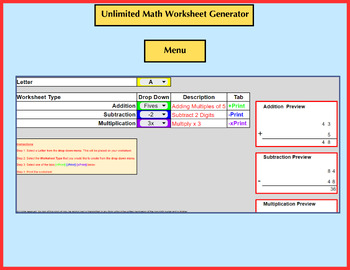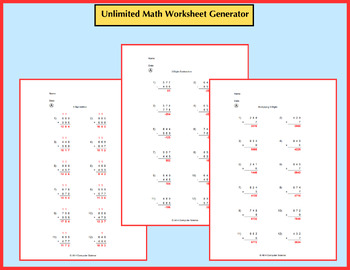Unlimited Math Worksheet Generator [+ - x]
- XLSX
Also included in
- This Bundle is always being updated!Current Total 446 PowerPoint Slides54 Lessons54 Quizzes38 Activities2 Test4 ProjectsLessonsComputer Science [1]Cyber Security [4]Internet Functions [8]Operating Systems [4]JavaScript [5] Binary Numbers [6] + Instructional Videos made by ©All 4 Computer ScienceAlgPrice $29.99Original Price $142.99Save $113.00
Description
The Unlimited Math Worksheet Generator [spreadsheet] is a powerful tool that allows educators and parents to create an unlimited number of printable math worksheets for students. Whether you need practice sheets for adding, subtracting, multiplication or any other math concept, this generator has you covered. Say goodbye to running out of worksheets or spending hours creating them by hand – with this tool, you can generate as many worksheets as you need with just a few clicks.
Product Features:
- Create unlimited printable math worksheets.
- Customize worksheets to focus on specific math skills, such as adding, subtracting, or multiplication.
- Generate worksheets with varying levels of difficulty to cater to different skill levels.
- Save time and effort by quickly generating worksheets instead of creating them manually.
- Perfect for teachers looking to provide extra practice or homework assignments to students.
- Ideal for parents who want to support their child's learning at home.
- Easy to use interface with intuitive controls for generating and customizing worksheets.
For questions concerning this Math Generator please contact me at Allforcomputerscience@gmail.com




